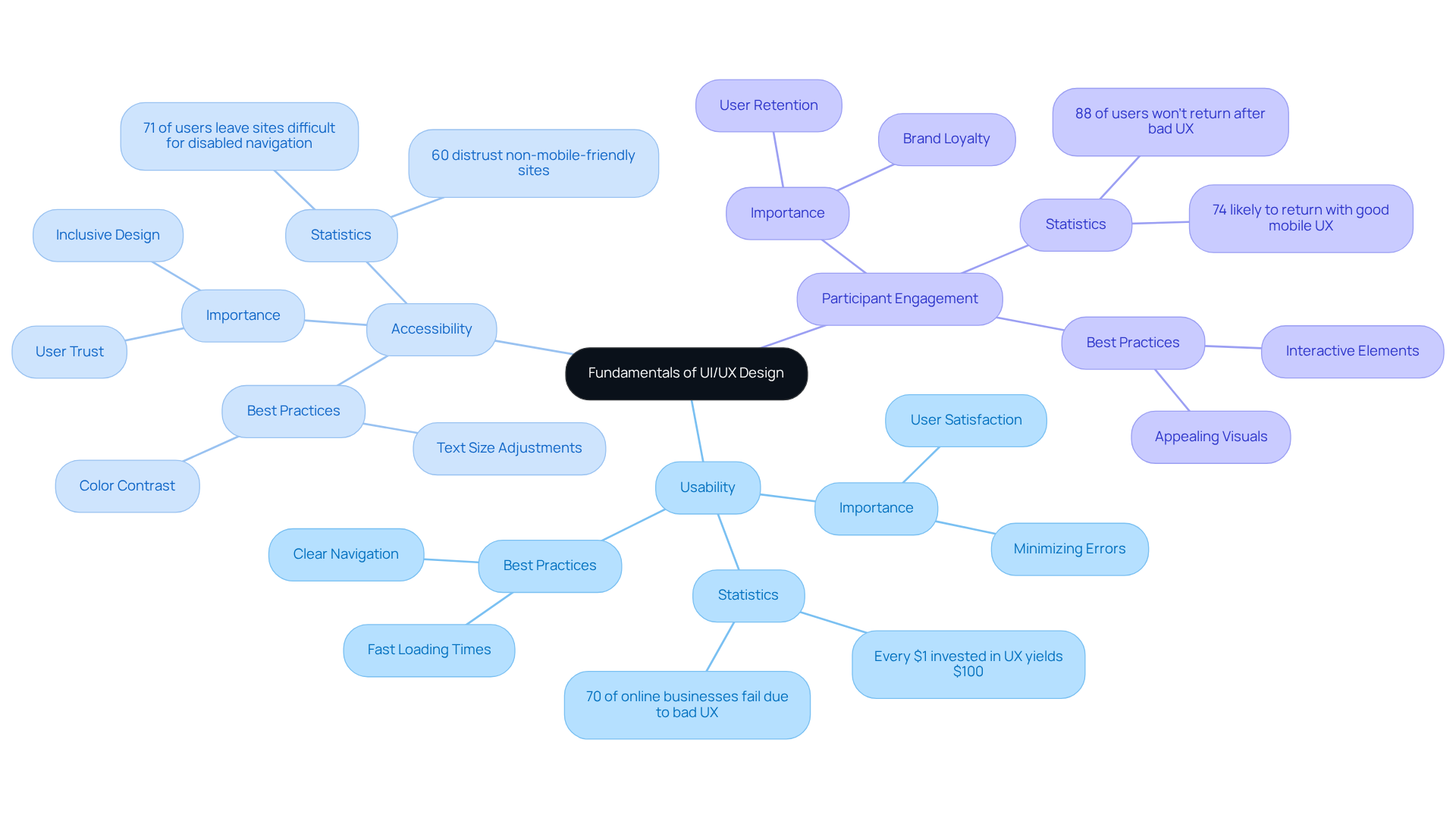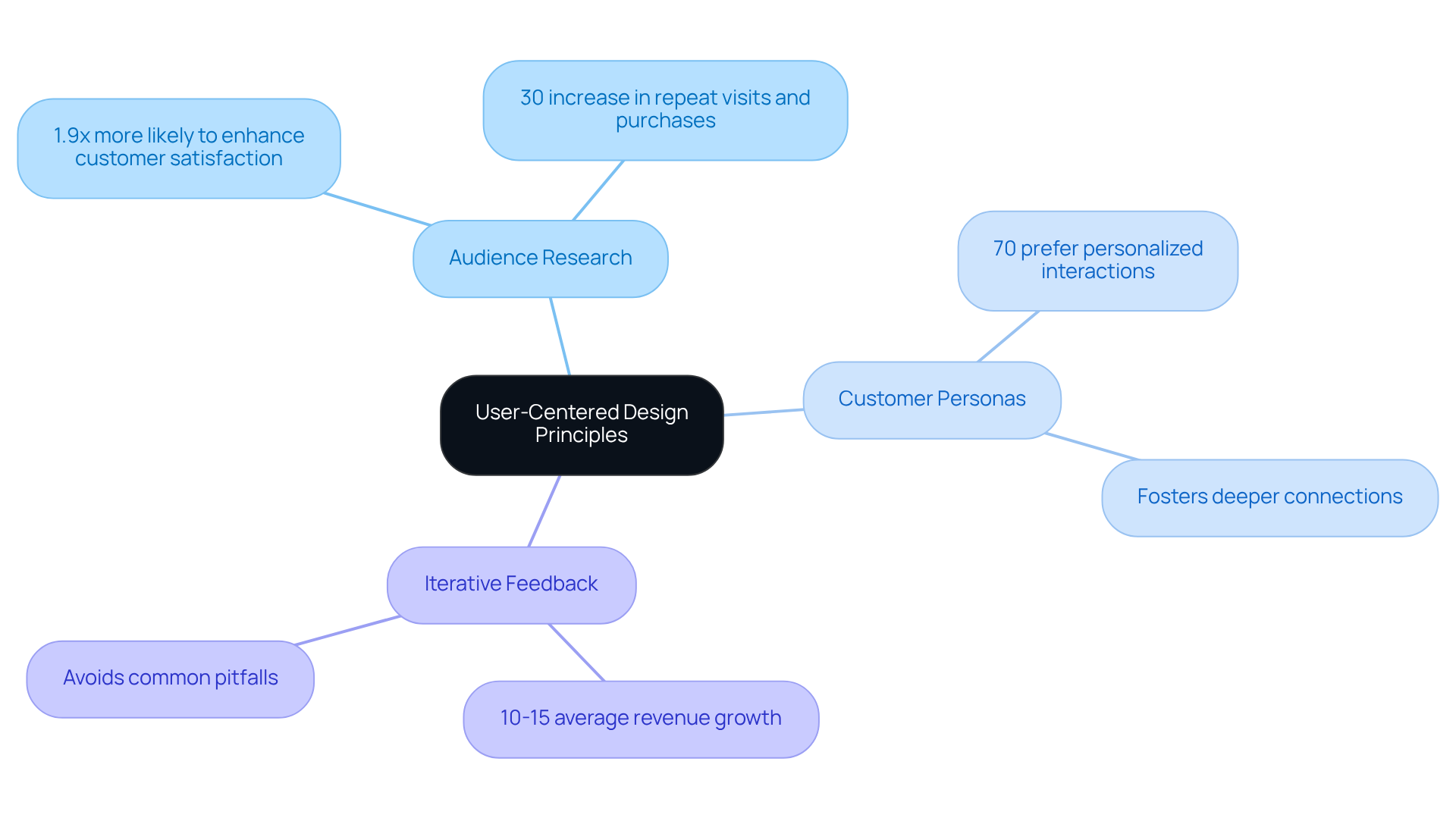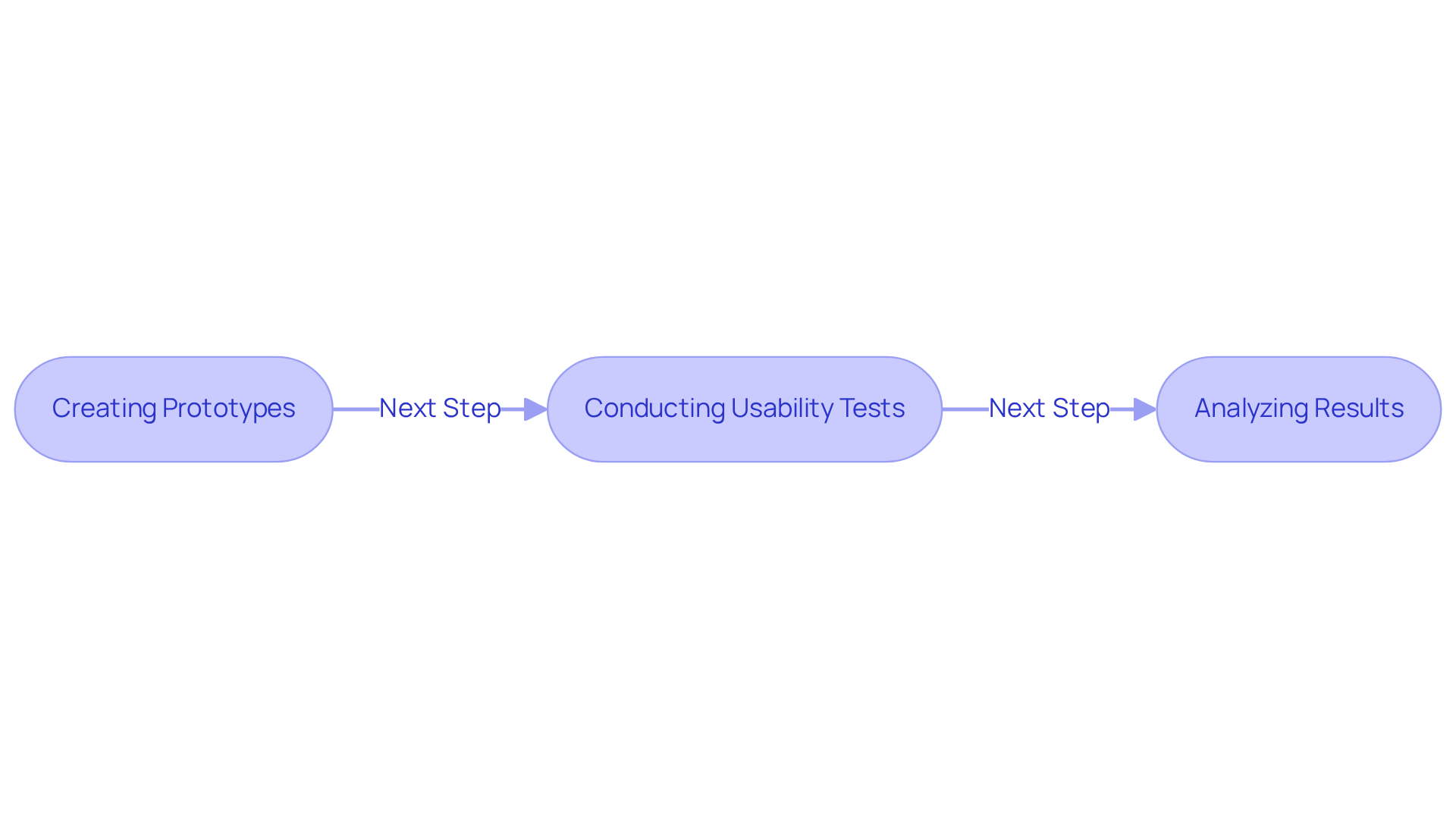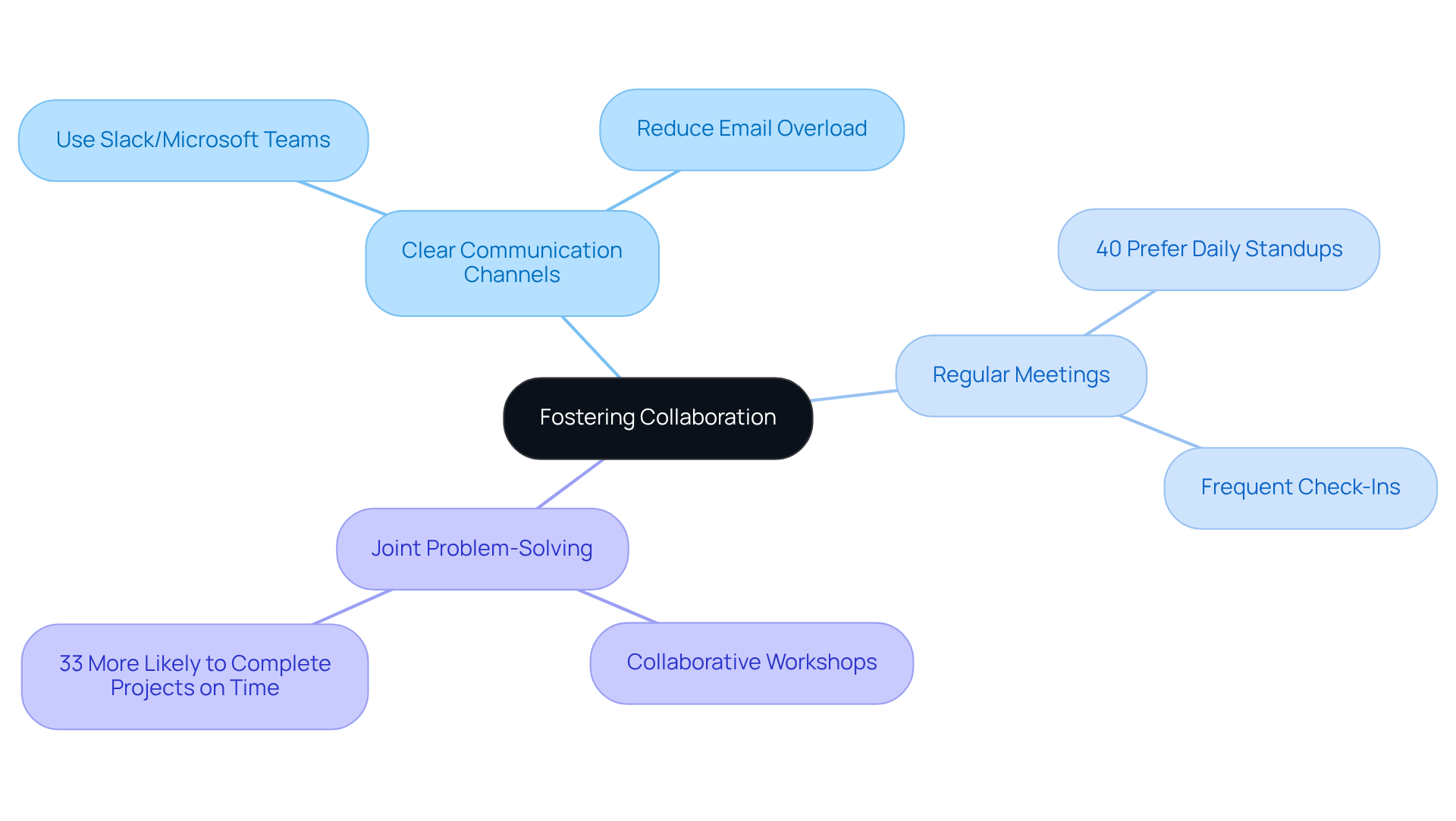Overview
In the fast-paced world of startups, one of the most pressing challenges is ensuring effective UI/UX design. Founders often find themselves grappling with usability issues that can lead to frustration for users, impacting satisfaction and retention. This struggle can feel overwhelming, especially when the success of a product hinges on how well it meets user needs.
However, there is hope. By prioritizing usability and implementing user-centered design principles, startups can create experiences that resonate with users on a deeper level.
Regular usability testing is crucial, allowing teams to gather feedback and make informed improvements. Moreover, fostering collaboration between design and development teams ensures that everyone is aligned in their mission to enhance the user experience.
This nurturing approach not only leads to significant financial returns but also cultivates customer loyalty. Remember, focusing on usability and continuous improvement can transform your startup into a beacon of user satisfaction, and we are here to support you on this journey.
Introduction
In the competitive landscape of startups, the importance of effective UI/UX design is deeply felt. Many entrepreneurs find themselves striving to create products that not only function well but also bring joy to users. This journey can be daunting, as understanding the essential practices that lead to successful design is crucial.
This article delves into four key practices that have the potential to transform user experiences and foster customer loyalty. It highlights the pressing need for startups to navigate the complexities of design with intention and insight.
How can emerging businesses ensure their digital offerings resonate with users while nurturing collaboration and continuous improvement? Together, let's explore these challenges and discover supportive solutions that can guide you on this path.
Understand the Fundamentals of UI/UX Design
Creating a successful ui/ux design can feel daunting for startups, especially when it comes to ensuring . Many entrepreneurs struggle with understanding how to make their products not just functional, but truly enjoyable to use. This challenge can lead to frustration, as a lack of usability can result in lost customers and diminished brand loyalty.
One of the most critical aspects to consider is usability. It’s about how effortlessly users can navigate and interact with your product. When usability is prioritized, it minimizes user errors and enhances overall satisfaction. Research shows that , there’s the potential for a return of up to $100. This isn’t just a statistic; it’s a testament to the financial benefits of ui/ux design that creates a resonating with your audience.
Accessibility is another vital component. It's essential to ensure that your products are usable by everyone, regardless of their abilities or disabilities. This means paying attention to details like color contrast, text size, and alternative text for images. Consider this: that are challenging to navigate for those with disabilities. This statistic highlights the urgent need for that welcome all users.
Equally important is participant engagement. It’s not enough to draw users in; you must also keep their interest alive. Intuitive navigation, appealing visuals, and interactive elements can make all the difference. by an impressive 211% over the past decade, demonstrating the enduring value of captivating experiences.
By mastering the fundamental principles of ui/ux design, new businesses can build a strong foundation for . This will lead to enhanced experiences for clients and improved retention rates. As industry specialists wisely note, "A seamless interface is the silent representative of your brand." This statement underscores the importance of thoughtful planning in fostering customer loyalty. Remember, you’re not just designing a product; you’re creating an experience that can resonate deeply with your users.

Implement User-Centered Design Principles
To effectively implement , startups often face the challenge of truly understanding their customers. This can lead to feelings of uncertainty and frustration, as the needs and preferences of potential users remain unclear. However, by embracing certain key practices, startups can navigate this journey with confidence and compassion.
- is essential. Engaging potential participants through surveys, interviews, and focus groups allows startups to gather valuable insights about their needs and preferences. Research shows that firms emphasizing consumer research are 1.9 times more likely to report . Imagine how a smoother experience can enhance brand likability—resulting in a 30% increase in repeat visits and purchases. This approach not only validates the startup’s direction but also fosters a sense of connection with the audience.
- can significantly guide creative choices. By developing detailed profiles of target individuals, startups can ensure their products resonate with specific client needs, ultimately improving the overall experience. Statistics reveal that 70% of consumers favor personalized interactions, making customer personas vital for effective creation. This nurturing approach in ui/ux design allows startups to perceive their customers as unique individuals, .
- is crucial. Continuously refining and enhancing the ui/ux design using input from individuals aligns the offering with consumer expectations and fosters loyalty and satisfaction. Companies that implement iterative usability testing often experience an average revenue growth of 10%-15% compared to their competitors. Yet, it’s important for new ventures to be mindful of common pitfalls, such as not involving a diverse audience or failing to iterate based on feedback.
By embracing these methods, startups can develop offerings that not only satisfy customer needs but also foster enduring loyalty and contentment. Remember, the journey of understanding and connecting with your audience is a shared experience, and with each step, you’re creating a community that values compassion and innovation.

Conduct Regular Usability Testing and Iteration
For many startups, establishing a routine for can feel daunting. Yet, the importance of this practice cannot be overstated. By embracing usability testing in , you can ensure your product resonates with users, ultimately leading to greater satisfaction and retention. Let's explore how you can effectively implement this vital process.
Creating Prototypes: Begin by developing to test your concepts before diving into full-scale development. This approach not only allows for swift feedback but also enables you to make necessary modifications early on. As industry experts remind us, 'Design isn’t finished until somebody is using it.' This highlights the crucial role of in validating your ideas. Moreover, companies that invest in have seen an average revenue growth of 10%-15%, illustrating the tangible benefits of this practice.
Conducting Usability Tests: Next, organize sessions where real users can engage with your product while observers take note of any challenges they face. This involvement can uncover that might escape the development team's notice. Research indicates that testing with just five participants can reveal up to 85% of usability problems, making it a cost-effective strategy for new ventures. As Steve Jobs wisely stated, 'You’ve got to start with the and work backwards for the technology.' This reinforces the value of in your ui/ux design prototyping efforts.
Analyzing Results: Finally, to uncover patterns and identify areas for improvement. This iterative process is essential; as Steve Krug puts it, 'If you want a great site, you’ve got to test.' By leveraging insights from your testing, you can refine your ui/ux design to better meet the needs of your clients. It's also important to be mindful of common pitfalls, such as overcomplicating prototypes or disregarding user feedback, as these can undermine the effectiveness of your testing.
By prioritizing usability testing in ui/ux design, you can ensure that your offerings are intuitive and align with consumer expectations. This commitment not only enhances user satisfaction but also fosters a culture of continuous improvement—an essential element for thriving in today's competitive market. Implementing these practices can significantly influence customer satisfaction and retention, paving the way for your long-term success.

Foster Collaboration Between Design and Development Teams
In the fast-paced world of startups, between design and development teams can often feel like a daunting challenge. Miscommunication and misunderstandings can lead to frustration, impacting not only project outcomes but also team morale. It’s a common struggle that many founders face, and it’s essential to address it with care and intention.
To alleviate these pain points, startups should first establish . Utilizing tools like can create a space for ongoing dialogue, ensuring that everyone is aligned on project goals. When teams communicate effectively, they can significantly reduce turnover rates—companies that prioritize teamwork experience a 50% lower . This highlights just how crucial clarity is in team interactions, fostering a sense of unity and purpose.
Regular meetings can also play a vital role in enhancing collaboration. Scheduling frequent check-ins allows teams to discuss progress, challenges, and feedback in a . Research reveals that as the best way to stay connected remotely, reinforcing the idea that regular communication keeps both teams informed and engaged.
Moreover, encouraging can create invaluable opportunities for designers and developers to tackle challenges together. When teams collaborate, they are , nurturing a culture of innovation and teamwork.
By implementing these nurturing practices, startups can not only but also improve the and streamline the development process. This ultimately leads to better user experiences and increased satisfaction among team members, creating a supportive community that thrives on collaboration.

Conclusion
Creating an effective UI/UX design is not just a technical endeavor; it is a holistic approach that can significantly impact a startup's success. Many founders struggle with this, feeling overwhelmed by the complexities of design. However, understanding and implementing core practices in UI/UX design can lead to enhanced user satisfaction, increased customer loyalty, and ultimately, greater financial returns. It's essential to recognize that you are not merely developing products; you are crafting experiences that resonate deeply with your audience.
Key insights discussed include:
- The importance of usability
- Accessibility
- User-centered design principles
By conducting thorough audience research, creating customer personas, and engaging in regular usability testing, you can align your offerings with user expectations. Moreover, fostering collaboration between design and development teams enhances communication and innovation, ensuring that projects are completed effectively and efficiently.
In a rapidly evolving digital landscape, the significance of these practices cannot be overstated. As a startup founder, prioritizing user experience is crucial to your business strategy. By embracing these essential practices for effective UI/UX design, you can not only meet but exceed user expectations, paving the way for long-term success and a loyal customer base. Remember, the journey of creating impactful digital experiences is ongoing, and your commitment to continuous improvement will ultimately define your startup's legacy in the marketplace.
Frequently Asked Questions
What is the primary challenge startups face in UI/UX design?
Startups often struggle to make their products not just functional, but also enjoyable to use, which can lead to user dissatisfaction and lost customers.
Why is usability important in UI/UX design?
Usability is crucial because it determines how effortlessly users can navigate and interact with a product. Prioritizing usability minimizes user errors and enhances overall satisfaction.
What financial benefits can be gained from investing in user experience?
Research indicates that for every dollar invested in user experience, there is the potential for a return of up to $100, highlighting the financial advantages of effective UI/UX design.
How does accessibility factor into UI/UX design?
Accessibility ensures that products are usable by everyone, regardless of their abilities or disabilities. This includes attention to color contrast, text size, and alternative text for images.
What statistic emphasizes the importance of accessible design?
71% of individuals will abandon websites that are difficult to navigate for those with disabilities, underscoring the need for inclusive design practices.
What role does participant engagement play in UI/UX design?
Participant engagement is essential for keeping users interested. Intuitive navigation, appealing visuals, and interactive elements are key to maintaining user interest.
How have companies that focus on aesthetics performed in comparison to the S&P 500?
Companies that prioritize aesthetics have outperformed the S&P 500 by 211% over the past decade, demonstrating the value of captivating user experiences.
What is the overall goal of mastering UI/UX design principles for new businesses?
By mastering UI/UX design principles, new businesses can create a strong foundation for their digital products, leading to enhanced user experiences and improved retention rates.
What does a seamless interface represent for a brand?
A seamless interface acts as a silent representative of a brand, highlighting the importance of thoughtful planning in fostering customer loyalty and creating meaningful user experiences.




